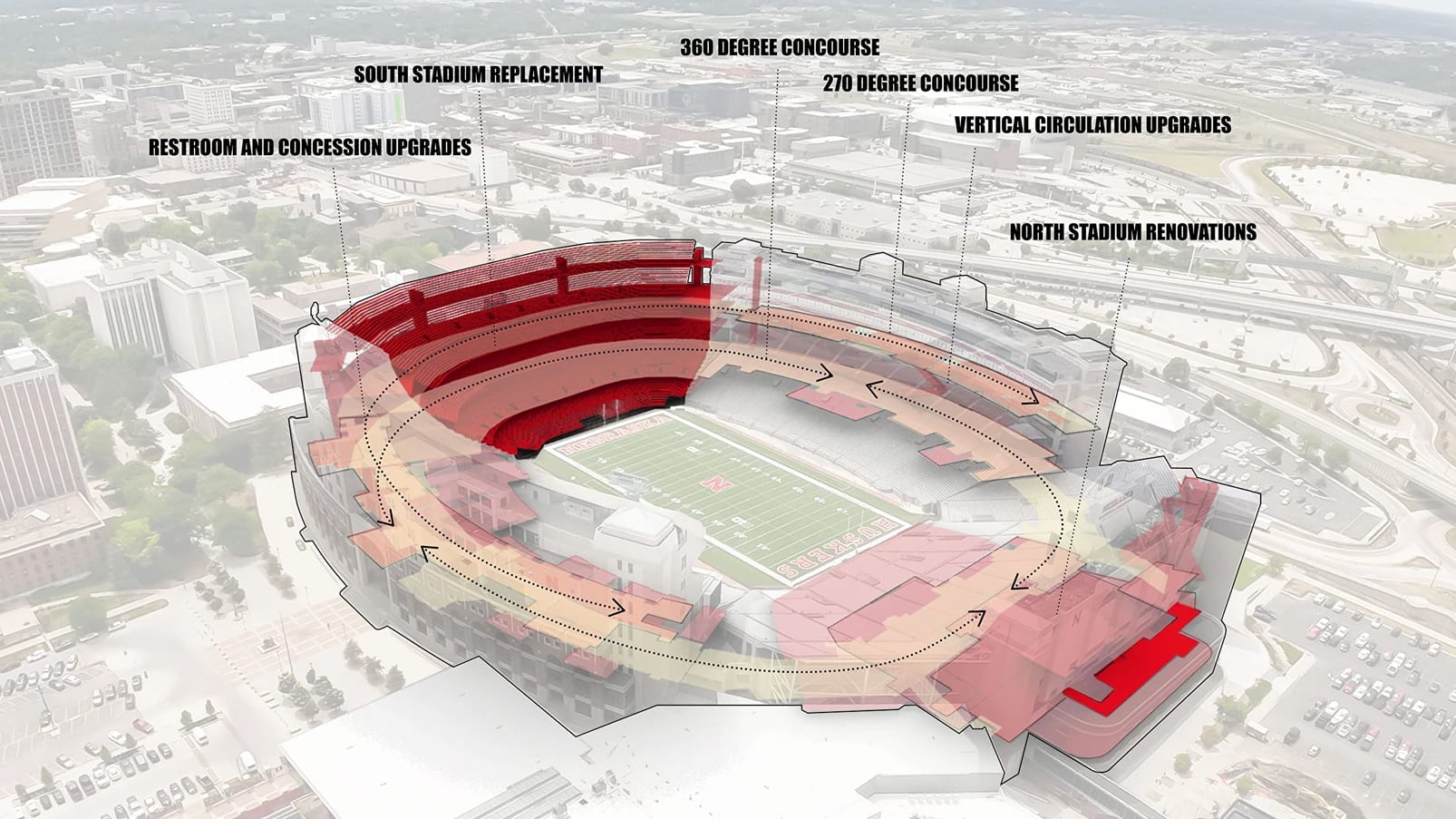
When I went to my first Cornhusker home football game, I sat wide-eyed in the North Stadium on the ancient wooden bleachers, totally focused on the action. I was overwhelmed by the sight of 76,000 red-clad fans. I marveled at the speed of the game. I yelled as the Blackshirts crashed into enemy ball carriers, hoped the Huskers could stay undefeated, and didn’t give the unforgiving seats a second thought. I didn’t think about hot dogs, popcorn or soda, either, until my friend’s uncle, who invited us and paid our way into to the game, graciously bought some for me.
A generation later, when I took my son went to his first Husker game, we sat on the wooden bleachers in the South Stadium. We were completely dialed in to the game, focused on the way Brook Berringer and the undefeated Huskers executed their assignments, loved listening to the band, and didn’t give our less-than-premium surroundings a second thought.
Ever since Trev Alberts championed the project last year, there’s been a lot of discussion about a proposed $450 million remaking of Memorial Stadium to improve the fan experience. So what’s the big deal about amenities in Memorial Stadium? Who needs a stadium upgrade, anyway? True fans care about the game, not about escalators, Wi-Fi and cupholders.
Or do they?
Well, for one thing, my son and I have gotten a little older since then. But is attracting older fans the major concern for the folks who worry about football revenue? What about the younger folks? Do they give a rip about how hard their bench seat is in 2024, or how crowded it is in their row? Heck, they’re standing up half the game anyway, if the team is good. Or so the argument goes.
That’s the priority, right? To make sure the team is good? Well, I can’t argue with that, at least to a point.
That’s the attitude that prevails in Kansas City. That’s the message Jackson County, Missouri, voters just sent to the Royals. On April 2, by a 58-to-42 percent margin, they voted not to continue a modest 3/8-cent sales tax for another 40 years, a tax that would have helped pay for a major upgrade to publicly owned Arrowhead Stadium, and would have all but guaranteed that the Royals relocate within eight years from publicly owned Kauffman Stadium to a downtown site in the Power & Light District. Taxpayers, most of whom have no concept about how much maintenance will be needed in the long term, were not excited about that prospect, so they gave the middle finger to majority owner John Sherman for what is popularly perceived in KC as “wanting to spend a ton on the stadium while not spending enough on the baseball team.” Right or wrong, that populist “stick-it-to-the-rich-man” gesture may prove to be short-sighted. (Indeed, the Royals, after spending a higher-than-normal amount on free agents, are off to their best start in years this spring.) Especially if it leads to the franchise moving out of the region.
That may not be a straight apples-to-apples comparison (the Huskers are not going to leave Lincoln anytime soon, although players, coaches and athletic directors come and go). But the concept is worth considering. Would the Royals’ stadium upgrade, despite all its bells and whistles, really improve the product on the field? Would an upgrade to Memorial Stadium improve the Huskers’ performance?
As Troy Dannen, Nebraska’s new AD, recently put it during his introductory press conference, “How will it help us win?” That’s a fair question. The word “undefeated” certainly plays a large part in my fond recollection of my first experience at Memorial Stadium, with its World War II-era sound system and its narrow stairways. The Huskers were winning, and presumably that was the “fan experience” everyone cared most about. But even when the Huskers start winning again, I think most fans in their 30s and above will demand an upgraded stadium, sooner rather than later.
It could be argued that installing wider, more comfortable chairback seats won’t necessarily help Nebraska win. Neither would installing concourses that allow fans to walk most of the way around the field, nor would selling beer in the stadium, nor would allowing sports gambling there. But moving the student section down to as close to field level as possible and spreading them all the way across the south end zone absolutely would help the team win.
In this case, I agree with Alberts, who said, “Why wouldn’t we embrace our students to drive the energy in the stadium?” It wouldn’t take long before a noise-induced false start penalty on an enemy offensive lineman would make difference between the success or failure of an opponent’s drive late in the game. But is the whole package — with its more comfortable seats in nearly three-quarters of the stadium, better access to the upper levels of the stadium, expanded restrooms and a bunch of fancy gathering spaces — too much of a good thing? Can enough donors be convinced that modest creature comforts are worth it?
Nebraska can — and should — do two things at once. The university makes the much-needed improvements to the stadium, and Matt Rhule continues the much-needed improvements to the football team.
Nebraska fans shouldn’t abandon Alberts’ stadium renovation ideas, despite the fact that Alberts left town. Love him or hate him, he had a good plan. A lot of time and effort, including a survey of Husker fans that yielded 22,000 responses, already has gone into the concept. It makes too much sense not to give it a long, hard second look, maybe make some minor revisions, then press ahead.
Millions look forward to the day when the Huskers return to a Top 25 level, but it doesn’t have to be a mutually exclusive choice between improving the team and improving the stadium. If there’s a good enough plan, there’s enough private money to spend half a million on the stadium upgrade and keep NIL coffers well funded in Lincoln. The “Go Big” project will be completely paid off by June, according to CFO Doug Ewald.
I say the plan is good enough. I disagree with those who claim that the present stadium is not worth saving. “You should start from scratch and build a domed stadium instead,” they say. I heard that argument 40 years ago. It didn’t make sense then, and it makes even less sense now, after all the investment that’s been made in the stadium over the past two decades, and in the huge, beautiful buildings that are connected to it. There isn’t room on campus for a new stadium, and to place it elsewhere would be a financial loser for the city.
As for a dome, the idea is ludicrous. In Pinnacle Bank Arena, Lincoln already has a prime indoor spot for everything from large concerts to monster car rallies. Why should Nebraska reduce its chance to recruit, develop and acclimate players who hope to play someday at NFL sites like Pittsburgh, Cleveland, Cincinnati, Green Bay, Philadelphia, Baltimore, New York or New England? It makes no more sense for Nebraska to tear down Memorial Stadium than it does for Ohio State to demolish the Horseshoe or Notre Dame to start another stadium from scratch.
There are those who bemoan the reduced stadium seating capacity that inevitably comes with Alberts’ plan. That’s a non-negotiable, simply because of the space required to accommodate wider seats, wider aisles, handrails and ADA-mandated changes. But it’ll be better to have people on the waiting list for season tickets once again instead of seeing large gaps in the crowd. Yes, it will be a major inconvenience for at least one season, and maybe two, because there’s no feasible way to improve the South Stadium without demolishing it first. But we’ll get through it.
I’ve heard the argument that it makes no sense to start the project right now. Why lose momentum by drastically limiting capacity just as the Huskers appear to be on the cusp of putting out a much-improved product? Here’s the counter: Why should Florida State rip out much of the east and west stands at 74-year-old Doak Campbell Stadium right after the Seminoles proved themselves a legitimate College Football Playoff contender? Yet that’s exactly what’s happening. This fall, Seminole fans will have access to only a limited number of temporary chairback seats on the stadium’s west side, which won’t be finished until August 2025. All this in a stadium that’s already been expanded or modified 11 times.
When will there be a better time to start this major Memorial Stadium renovation? I favor moving forward immediately after the 2024 season ends if fundraising will support it. If it has to be postponed a year to raise enough upfront money, then so be it.
Here’s an idea: share the pain. How about a temporary revolving lottery season ticket system, whereby ticketholders all over the stadium lose their seats for a game or two to accommodate those whose South Stadium seats will be gone? And maybe some temporary seating — completely for student use — can be installed at the south end of the field during construction. It’s already been done; they called it the “knothole section” in the 1950s and early ’60s.
If there’s a better plan out there, let’s hear it.

Must See
-


Football
/ 2 months agoHuskers Fight Hard but Fall Short Against UCLA
LINCOLN – The Nebraska Cornhuskers gave it their all on Saturday, with standout efforts...
-
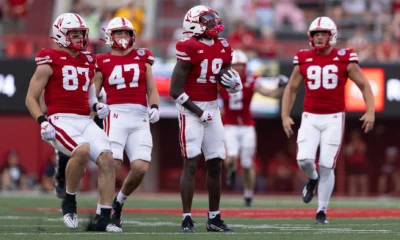

Football
/ 2 months agoGAMEDAY: Nebraska Set to Face Undefeated Indiana in Key Big Ten Showdown
Bloomington, IN – It’s Game Day, Husker Nation! Nebraska (5-1, 2-1 Big Ten) returns...
-


Football
/ 3 months agoBlackshirts Shine as Nebraska Tops Rutgers 14-7 on Homecoming
Lincoln, NE – Nebraska’s Blackshirt defense played a starring role in the Huskers’ 14-7...
By Chris
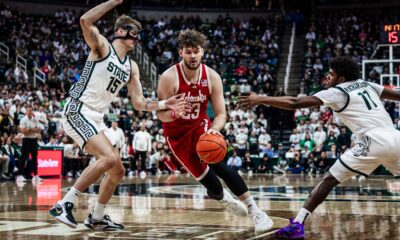

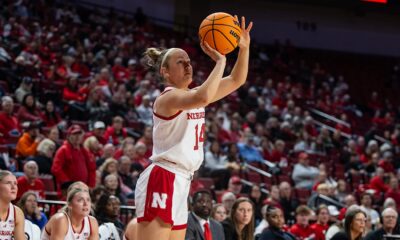

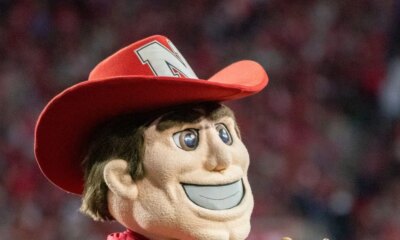





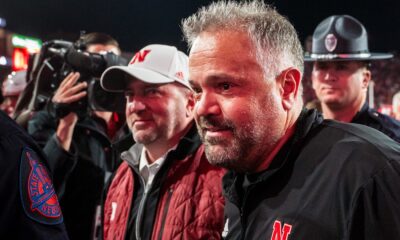




You must be logged in to post a comment Login